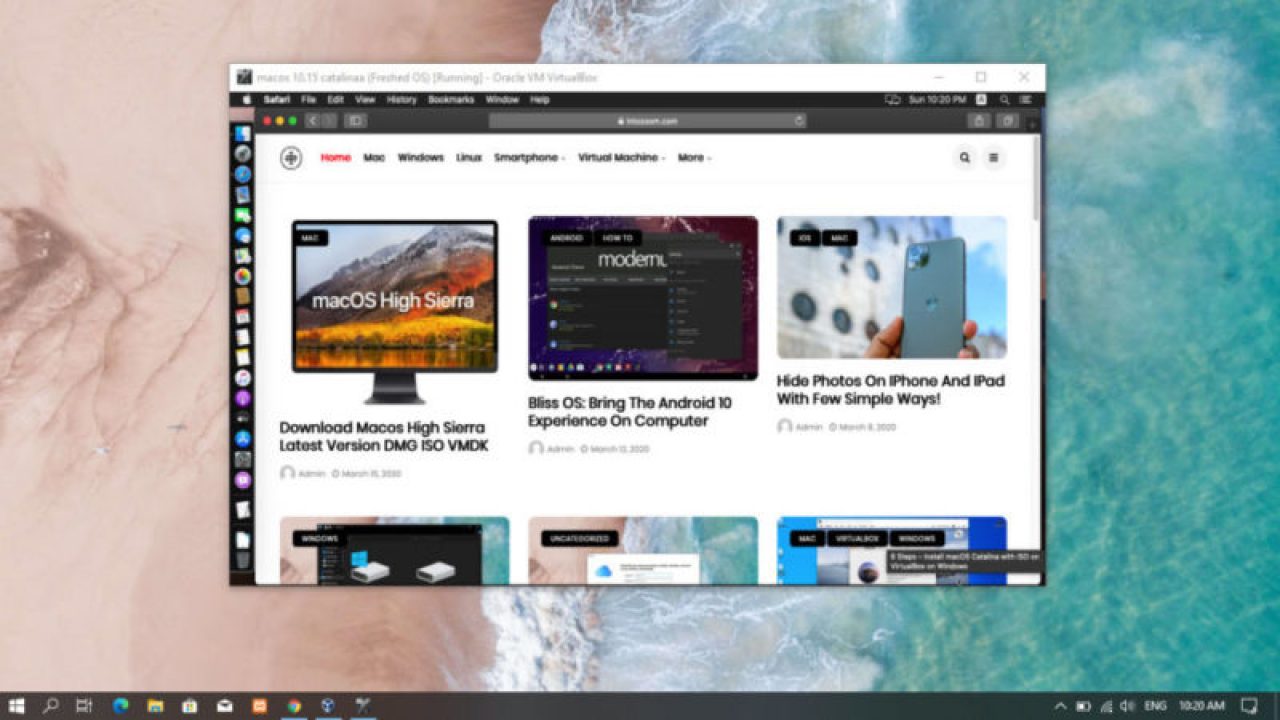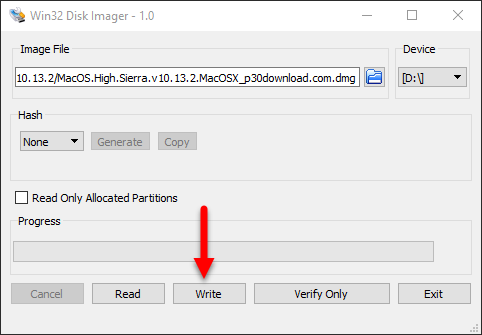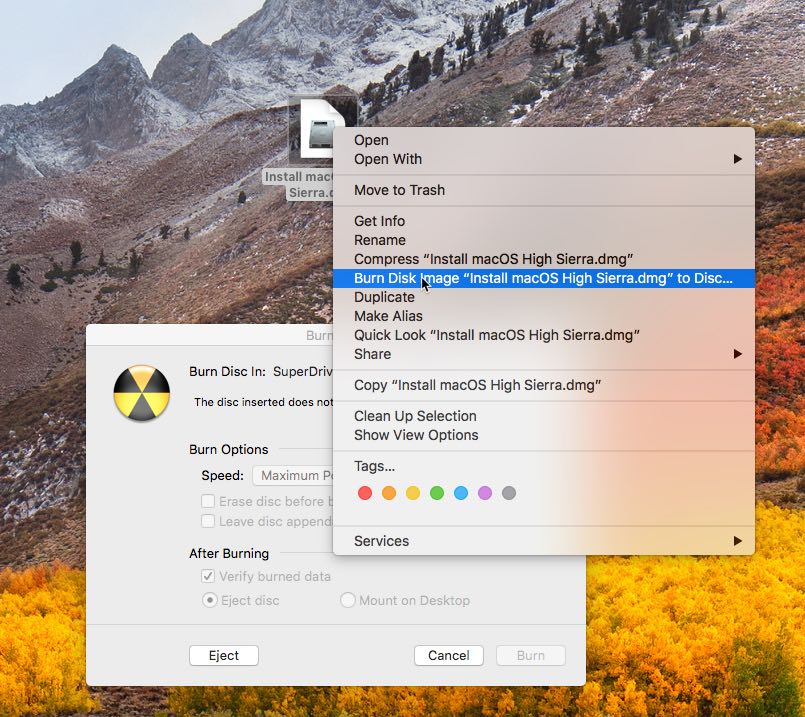

- #CREATE BOOTABLE DVD MAC OS HIGH SIERRA DMG IN WINDOWS 10 INSTALL#
- #CREATE BOOTABLE DVD MAC OS HIGH SIERRA DMG IN WINDOWS 10 DRIVERS#
- #CREATE BOOTABLE DVD MAC OS HIGH SIERRA DMG IN WINDOWS 10 SOFTWARE#
- #CREATE BOOTABLE DVD MAC OS HIGH SIERRA DMG IN WINDOWS 10 CODE#
Updated Download Links for macOS Mojave 10.14.6_18G103īrowse Apple's Regular Software Catalog and find the URLs to download the following 6 installer files. Copy/download to "Macintosh HD", then run in terminal (after attaching DATA USB with /Shared Support folder). The above steps can be automated with the attached "mand" script, which will assemble "Install macOS High Sierra.app" on "Macintosh HD" and launch the startosinstall utility targeting the "Macintosh HD" volume.
#CREATE BOOTABLE DVD MAC OS HIGH SIERRA DMG IN WINDOWS 10 INSTALL#
Reboot the system to the USB installer to install High Sierra. In the screenshots below, I have attached the USB Installer (in this case PhysicalDrive7) to my macOS Virtual Machine. If you want to use the installer to run High Sierra in Windows on VMware, you can follow my guide to set up the Virtual Machine and replace Clover's default config with EFI_Clover for VMware (which is compatible to run in VMware).
#CREATE BOOTABLE DVD MAC OS HIGH SIERRA DMG IN WINDOWS 10 DRIVERS#
If UEFI booting, you will most likely need one of the OsxAptioFixDrv-64 drivers copied from /EFI/CLOVER/drivers-off/drivers64UEFI to /EFI/CLOVER/drivers64UEFI. You may need to add VoodooPS2Controller for your laptop keyboard/trackpad to work. NB BootDiskUtility by default already has FakeSMC.kext installed here. Kexts eg FakeSMC, NullCPUPowerManagement ->EFI/CLOVER/kexts/ or /Other. DSDT.aml with or without SSDT.aml->EFI/CLOVER/ACPI/patched (don't need one if your DSDT is auto patched by Clover in ist). The location of the important configuration files for Clover are summarized below Also, look at the Clover Wiki, Clover Instructions and Clover Configuration Thread for pointers and edit /EFI/Clover/ist accordingly with Wordpad or Notepad. If not, the hackintosh-vanilla-desktop-guide has some good explanations on the various settings available and also offers sample configuration files based on CPU type. The default ist (in the Clover FAT32 partition of the USB) maybe sufficient to boot your machine if you’re lucky. A browser download manager (eg Chrono for Chrome, dTA for FireFox) is handy since InstallESD is >4GB -> allows you to pause/resume interrupted download.Ģ) Rename InstallESDDmg.pkg to InstallESD.dmgĬlover configuration is required now. To a folder named "SharedSupport" on your Windows NTFS drive. (Hint - search page for "InstallESD" to find its URL and others nearby) Boot Disk Utility vrev021b from TransMac (free 15 day trial)ĭownload Installer Files Directly from Appleġ) Browse Apple's Regular Software Catalog and find the URLs to download the following 6 installer files. Edit: Recommend 16GB or larger for macOS Catalina 10.16 link to Apple's Software Catalog provides us with all the URLs necessary to download the needed files directly from Apple instead of some dubious source from the internet.ĨGB or larger USB drive. This is a proof of concept tutorial, to show it's possible to create a vanilla High Sierra installer, entirely from scratch, in Windows (even without App Store downloaded "Install macOS High Sierra.app" from a real Mac ). If you want to start over and wipe out the data, you need to go into Disk Utility to reformat the internal drive first, and then install macOS Sierra.Making a High Sierra USB Installer Entirely From Scratch in Windows If you want to install Sierra and leave the data intact, select Install OS X. Your Mac will display an OS X Utilites window. (You don’t need to select a network to proceed.) Click on the external drive and hit Return. After a few moments, your Mac should display the Startup Manager, which will show you the available boot drives. Press down on the Option key while the Mac boots. Plug your external drive into your Mac. You can quit Terminal and your drive is ready for use. You should see Terminal display a “Copy complete” and Done notice.  Terminal will copy the installer file to your drive. When that part is done, your Mac may ask you if you want to use the drive for Time Machine.
Terminal will copy the installer file to your drive. When that part is done, your Mac may ask you if you want to use the drive for Time Machine.  You’ll see that Terminal erases your drive. To confirm that you want to continue, type Y and hit Return. Terminal will tell you that it will erase your drive. Terminal doesn’t display characters when you type it in.
You’ll see that Terminal erases your drive. To confirm that you want to continue, type Y and hit Return. Terminal will tell you that it will erase your drive. Terminal doesn’t display characters when you type it in. #CREATE BOOTABLE DVD MAC OS HIGH SIERRA DMG IN WINDOWS 10 CODE#
Go back to Terminal and paste the copied code at the prompt.Sudo /Applications/Install macOS Sierra.app/Contents/Resources/createinstallmedia -volume /Volumes/Untitled -applicationpath /Applications/Install macOS Sierra.app Launch Terminal (/Applications/Utilities/Terminal.app).If your drive is named something else, you need to change Untitled to the name of your drive.) (In the Terminal command you will use, I use Untitled to represent your external drive. Connect the external drive to your Mac.







 0 kommentar(er)
0 kommentar(er)
